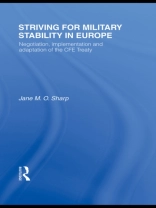First Published in 2004. This new book traces the changing relationship between Russia and NATO through the prism of conventional arms control, and focuses on the negotiation, implementation and adaptation of the Conventional Armed Forces in Europe (CFE) Treaty. It shows that arms control agreements reflect rather than affect rela tions between parties. The CFE Treaty codified parity between NATO and the Soviet-led Warsaw Treaty Organization (WTO) in November 1990, reflecting the status quo at the end of the cold war. The benefits were short lived for Russia, however. Although still widely viewed in the West as the cornerstone of security and stability in post-cold war Europe, from the Russian perspective the treaty was soon overtaken by events. With the collapse of the WTO and the Soviet Union in 1991, it became impossible to talk of a military balance between east and west in Europe, especially as all the former WTO states opted for membership in NATO. This study details how the other state parties worked hard to adjust and adapt the treaty to meet Russian concerns about its new weakness relative to NATO, and the issues that complicated Russian acceptance of CFE limits. This book will be of great interest to all students of Russia, NATO, European politics, international relations and strategic studies in general.
Jane M. O. Sharp
Striving for Military Stability in Europe [PDF ebook]
Negotiation, Implementation and Adaptation of the CFE Treaty
Striving for Military Stability in Europe [PDF ebook]
Negotiation, Implementation and Adaptation of the CFE Treaty
购买此电子书可免费获赠一本!
语言 英语 ● 格式 PDF ● 网页 288 ● ISBN 9781134325825 ● 出版者 Taylor and Francis ● 发布时间 2010 ● 下载 3 时 ● 货币 EUR ● ID 4492554 ● 复制保护 Adobe DRM
需要具备DRM功能的电子书阅读器












